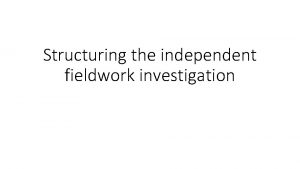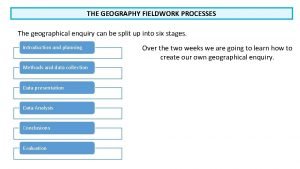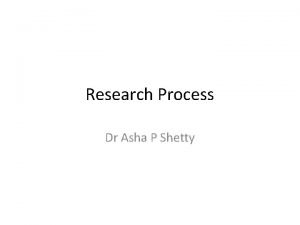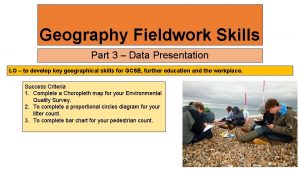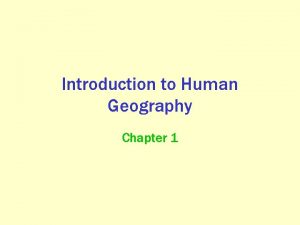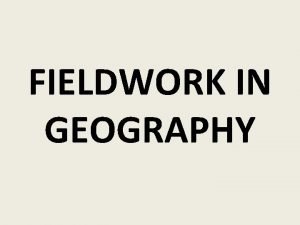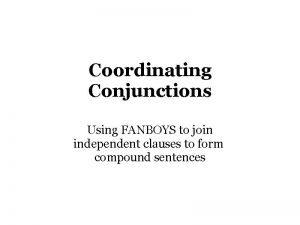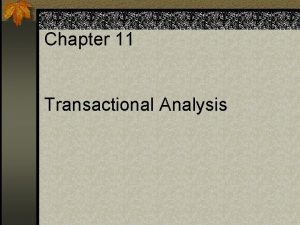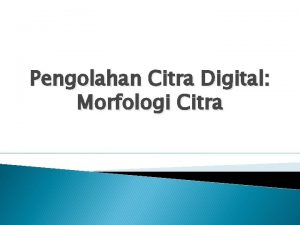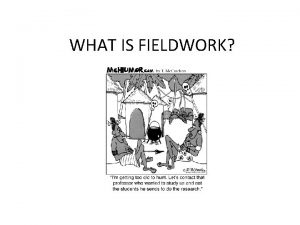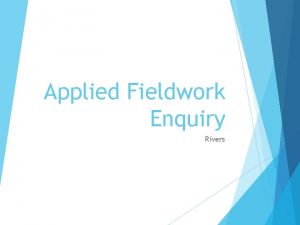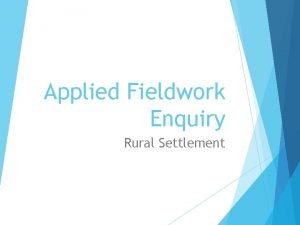Structuring the independent fieldwork investigation Purpose of enquiry











- Slides: 11

Structuring the independent fieldwork investigation

Purpose of enquiry Assessment criteria: To define the research questions that underpin field investigations AND to research relevant literature sources and understand write up theoretical/comparative context for the research question. (up to 10 marks) • 9 -10 marks: Research question is effectively identified and is completely referenced to the specification. Well supported- thorough use of literature. Theoretical/comparative context well understood and well stated. • 8 -6 marks: Research question is securely identifies that is explicitly linked to the specification. Supported by a focused use of literature sources. Theoretical/comparative context is consistently understood and stated. • 5 -3 marks: A research question which is partial. Links to the specification are imprecise. Supported by some use of literature sources. Theoretical/comparative context inconsistently stated. • 2 -1 marks: A research question which is generalised. Links to the specification are tentative. Limited/basic use of literature. Theoretical/comparative context is isolated.

Recommended structure • 500 -750 words • Introduce the background theory first. How does your investigation fit in to the bigger Geographical picture? What are the underlying concepts/theories and issues. Is there a model that needs introducing? Would reference to a wider world example be helpful? It is vital here that you show explicit use of relevant literature which is clearly referenced. • Introduce your study site- how is it appropriate for investigation? Make links to theory if appropriate. • Make explicit links to the specification- you may want to quote directly from the specification. • Provide annotated maps/aerial photos/sat. images at 2 scales to support an introduction to your site.

Methods of field investigation Assessment criteria: To observe & record phenomena in the field and devise and justify practical approaches taken. To demonstrate practical knowledge & understanding of appropriate field methodologies & to implement chosen methodologies to collect info/data of good quality to the topic (15 marks) 12 -15 marks: Detailed use of a range of techniques including sampling. Thorough & well justified data collection approaches. Detailed demonstration of practical knowledge & detailed implementation of chosen methodologies. 8 -11 marks: Clear use of appropriate techniques including sampling. Explicit justification of data collection approaches. Clear demonstration of practical knowledge & implementation of chosen methodologies. 4 -7 marks: Intermittent use of appropriate techniques including sampling. Some justification of data collection approaches. Intermittent demonstration of practical knowledge & partial implementation of chosen methodologies. 1 -3 marks: Basic use of appropriate techniques including sampling. Tentative justification of data collection approaches. Limited demonstration of practical knowledge & limited implementation of chosen methodologies.

Methods: What we would expect to see… • DETAIL & THOROUGHNESS: appropriate number of sites, awareness of value of frequency of recordings, awareness of equipment needs…. Consider the Dehlia test- parents should be able to replicate your methods! • JUSTIFICATION: All elements fully justified- why that site? What that duration of recording? Why that question? Why that resource? • MAPS: of sample sites • IMAGES: if help support the description of a method.

Recommended protocol (historically) Technique Primary or secondary? Justification V. IMP- of the technique and of the method Method V. IMP- must be very thorough Dehlia test Limitations Problems arising Solutions Don’t forget to consider what statistical test you intend to use as this could influence your method Accompanied by supporting materials e. g. Annotated site maps, questionnaire/interview justification, photos/images


Methods of critical analysis Assessment criteria: To demonstrate understanding of techniques appropriate for analysing field data and info. and for representing results, and show the ability to select suitable quantitative & qualitative approaches. To be able to interrogate and critically examine field data in order to comment on its accuracy and representativeness and to use to extend geographical understanding. To apply existing knowledge to understand field observations. (20 marks) 15 -20 marks: Demonstrates effective use of skills of representation and analysis. Thorough ability to select appropriate quantitative and qualitative approaches. Thorough ability to interrogate and comment on accuracy and representativeness of field data. Complete use of experience to extend geographical understanding & effective application of existing knowledge/theory and concepts to understand field data 10 -14 marks: Demonstrates precise use of skills of representation and analysis. Clear ability to select appropriate quantitative and qualitative approaches. Clear ability to interrogate and comment on accuracy and representativeness of field data. Secure use of experience to extend geographical understanding & focused application of existing knowledge/theory and concepts to understand field data 5 -9 marks: Demonstrates imprecise use of skills of representation and analysis. Some ability to select appropriate quantitative and qualitative approaches. Partial ability to interrogate and comment on accuracy and representativeness of field data. Inconsistent use of experience to extend geographical understanding & implicit application of existing knowledge/theory and concepts to understand field data 1 -4 marks: Demonstrates limited use of skills of representation and analysis. Basic ability to select appropriate quantitative and qualitative approaches. Limited ability to interrogate and comment on accuracy and representativeness of field data. Tentative use of experience to extend geographical understanding & tentative application of existing knowledge/theory and concepts to understand field data

Essentially consider it in 3 parts. . • Interrogation of data • Skills of representation • Critical analysis of data- description & explanation of findings where application of existing knowledge has been utilised.

Conclusions, evaluation & presentation Assessment criteria: To write field results clearly & logically, using a range of presentation methods. To evaluate and reflect on fieldwork investigations and explain how the results relate to a specific geographical question & the wider context. Draws effectively on evidence to make a well argued case. To show an understanding of the ethical dimensions of field research. (15 marks) 12 -15 marks: Thorough ability to write up clearly using a range of presentation methods. Complete explanation of how results relate to specific question & wider context. Effective evaluation and reflection. Draws effectively on evidence, well argued case. Thorough understanding of ethical dimensions. 8 -11 marks: Clear ability to write up clearly using a range of presentation methods. Precise explanation of how results relate to specific question & wider context. Secure evaluation and reflection. Clear understanding of ethical dimensions. 4 -7 marks: Some ability to write up clearly using a range of presentation methods. Imprecise explanation of how results relate to specific question & wider context. Partial evaluation and reflection. Some understanding of ethical dimensions. 1 -3 marks: Basic ability to write up clearly using a range of presentation methods. Generalised explanation of how results relate to specific question & wider context. Tentative evaluation and reflection. Limited understanding of ethical dimensions.

Requirements Range of data presentation methods applied and good comprehension. SPAG/structure Clear conclusions linking to key questions/overall question and wider context. Arguments are well evidence/substantiated. Evaluation; of all stages of investigation and the reliability/validity of your conclusions. Reflection of ethical dimension
 Purpose of enquiry
Purpose of enquiry Independent investigation meaning
Independent investigation meaning What is geographical enquiry
What is geographical enquiry Fieldwork sf
Fieldwork sf Undertaking clinical fieldwork
Undertaking clinical fieldwork Complex data presentation geography
Complex data presentation geography Field work ap human geography
Field work ap human geography Geography fieldwork in school grounds
Geography fieldwork in school grounds Fieldwork in geography
Fieldwork in geography Independent clause fanboys independent clause
Independent clause fanboys independent clause Script analysis in transactional analysis
Script analysis in transactional analysis Structuring element dapat berukuran
Structuring element dapat berukuran
